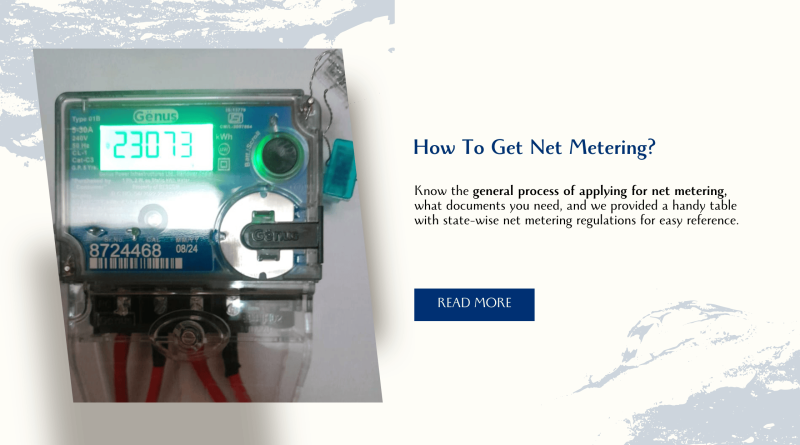How To Get Net Metering?
Net metering is a crucial mechanism for solar energy users in India, as it allows homeowners and businesses to offset their electricity bills by selling excess energy generated by their solar power systems back to the grid. Getting net metering involves specific steps, depending on your state and utility provider.
In this blog, we’ll outline the general process of applying for net metering, what documents you need, and provide a handy table with state-wise net metering regulations for easy reference.
Table of Contents
- 1 What is Net Metering?
- 1.1 Steps to Get Net Metering in India
- 1.1.1 1. Install a Solar PV System
- 1.1.2 2. Apply for Net Metering
- 1.1.3 3. Submit Required Documents
- 1.1.4 4. Technical Feasibility Report (TFR)
- 1.1.5 5. Inspection and Approval
- 1.1.6 6. Installation of Bi-Directional Meter
- 1.1.7 7. Sign Power Purchase Agreement (PPA)
- 1.1.8 8. Start Generating and Exporting Power
- 1.2 Documents Required for Net Metering Application
- 1.3 State-Wise Net Metering Regulations in India
- 1.4 Important Points to Keep in Mind
- 1.5 Conclusion
- 1.6 FAQs
- 1.1 Steps to Get Net Metering in India
What is Net Metering?
Net metering is a billing mechanism that allows solar panel owners to send excess electricity they generate back to the grid. In return, they receive credits on their electricity bill, reducing the overall cost of grid electricity consumed when the solar system isn’t generating power (e.g., at night or during cloudy weather).
Steps to Get Net Metering in India
1. Install a Solar PV System
- Ensure your solar photovoltaic (PV) system complies with your state’s regulatory guidelines and standards.
- Your solar installer should be certified by the Ministry of New and Renewable Energy (MNRE) or your state’s nodal agency.
- Size the system based on your average energy consumption and roof space availability.
2. Apply for Net Metering
- Approach your local Distribution Company (Discom) to request net metering services. Each Discom has a dedicated portal for net metering applications, or you can visit their office.
- Fill out the application form provided by the Discom, which may be available online or at their offices.
- Submit the application along with the required documents (listed below).
3. Submit Required Documents
- Application Form: Provided by the Discom.
- Proof of Ownership/Lease Agreement: Proof of ownership of the premises or a lease agreement if you are a tenant.
- System Layout and Specifications: Technical details of the solar PV system, including capacity, inverter details, and system layout.
- Installation Certificate: Issued by the installer, certifying that the system is installed according to MNRE guidelines.
- Electricity Bill: A copy of your latest electricity bill to verify your existing consumer details with the Discom.
- No Objection Certificate (NOC): In some cases, you may need an NOC from the local governing body or utility.
4. Technical Feasibility Report (TFR)
- After receiving your application, the Discom will assess whether the grid can handle your system’s energy output.
- They will issue a Technical Feasibility Report (TFR) stating whether your premises are suitable for a grid-tied system with net metering.
5. Inspection and Approval
- Once the feasibility study is complete, the Discom will send an official to inspect your solar installation and ensure compliance with safety and technical standards.
- Upon successful inspection, your system will be approved for net metering.
6. Installation of Bi-Directional Meter
- After approval, the Discom will install a bi-directional meter (also called a net meter) at your premises.
- This meter records both the electricity you consume from the grid and the excess energy you export to the grid.
7. Sign Power Purchase Agreement (PPA)
- Some states require you to sign a Power Purchase Agreement (PPA) with your Discom, specifying the terms of exporting electricity to the grid.
- The agreement typically includes the export tariff rate and other conditions.
8. Start Generating and Exporting Power
- Once the net meter is installed and operational, you can start feeding excess energy back into the grid and receive credits for the surplus.
Documents Required for Net Metering Application
| Document | Details |
|---|---|
| Application Form | Provided by the Discom, either online or offline. |
| Proof of Ownership/Lease Agreement | Proof of ownership of the property or lease agreement. |
| Technical Details of the Solar System | Specifications of your solar panels, inverter, and system layout. |
| Installation Certificate | A certificate from the installer verifying installation as per MNRE guidelines. |
| Latest Electricity Bill | To verify your consumer number and energy usage. |
| No Objection Certificate (NOC) | Required in some cases from the local governing authority or utility provider. |
| Power Purchase Agreement (PPA) | In certain states, this needs to be signed between the consumer and the Discom. |
State-Wise Net Metering Regulations in India
Net metering policies and guidelines can vary significantly by state. Here is a table summarizing key state-wise net metering policies as of 2024:
| State | Net Metering Availability | Eligible System Size (kW) | Max Capacity | Compensation for Surplus |
|---|---|---|---|---|
| Delhi | Yes | 1 kW to 1 MW | 100% of Sanctioned Load | Credit at Retail Tariff Rate |
| Maharashtra | Phasing out for large systems | 1 kW to 500 kW | 100% of Sanctioned Load | Lower than Retail Rate |
| Gujarat | Yes | 1 kW to 1 MW | 50% of Sanctioned Load | Credit at Retail Tariff Rate |
| Tamil Nadu | Yes | 1 kW to 999 kW | 100% of Sanctioned Load | Credit at Retail Tariff Rate |
| Karnataka | Yes | 1 kW to 1 MW | 100% of Sanctioned Load | Credit at Retail Tariff Rate |
| Uttar Pradesh | Yes | 1 kW to 2 MW | 100% of Sanctioned Load | Credit at Retail Tariff Rate |
| Rajasthan | Yes | 1 kW to 1 MW | 100% of Sanctioned Load | Credit at Retail Tariff Rate |
| Haryana | Yes | 1 kW to 2 MW | 100% of Sanctioned Load | Credit at Retail Tariff Rate |
| Kerala | Yes | 1 kW to 1 MW | 80% of Sanctioned Load | Credit at Retail Tariff Rate |
| Punjab | Yes | 1 kW to 1 MW | 80% of Sanctioned Load | Credit at Retail Tariff Rate |
Note: Policies may change, and you should always consult your state Discom for the latest regulations.
Important Points to Keep in Mind
1. Capacity Limits: Most states have a maximum capacity limit based on your sanctioned load. Ensure that your solar system’s size aligns with this limit.
2. Billing Cycle: Credits for excess energy are usually applied at the end of each billing cycle. Be aware of how your utility handles credits, especially when generating surplus electricity.
3. Discom Regulations: Each Discom may have slightly different procedures for net metering applications, so it’s important to check the specific guidelines for your area.
Conclusion
Getting net metering in India is a straightforward process, but it involves several key steps, including applying with your Discom, submitting the required documents, and ensuring your solar PV system complies with state regulations. With net metering, you can significantly reduce your electricity bills and even earn credits for the surplus energy you generate.
By following this guide, you can ensure a smooth and hassle-free experience in setting up net metering for your solar system in India.
Ready to Save on Electricity Bills with Solar Power?
With Net Metering, you can drastically reduce your electricity costs by generating your own solar power and sending any excess back to the grid. It’s time to harness the sun’s energy and make a positive impact on both your wallet and the environment!
At SolarClue, we make the transition to solar simple, efficient, and affordable. Whether you’re a homeowner, business, or institution, our team of solar experts will guide you through the process—from installation to maintenance—so you can start saving from day one.
🌞 Take the first step towards energy independence today!
🔋 Get your solar consultation now!
Contact SolarClue or call us at +91-888-4444-830 to explore the best solar solutions for your home or business.
Go Solar. Save More. Power Your Future with SolarClue!
FAQs
1. What is the cost of installing a net meter?
The cost of a bi-directional meter varies but is typically borne by the Discom or added to your installation costs.
2. How long does it take to get net metering approval?
The process can take anywhere from 2 weeks to a few months, depending on your Discom and location.
3. Can I apply for net metering after installing a solar system?
Yes, you can apply for net metering even after your solar system has been installed, provided it complies with the guidelines.
4. Do I need to replace my existing electricity meter for net metering?
Yes, a bi-directional meter needs to be installed to measure both import and export of energy.
5. What happens to the credits if I generate more energy than I use?
Any excess credits are usually carried forward to the next billing cycle or compensated according to your state’s net metering policy.




